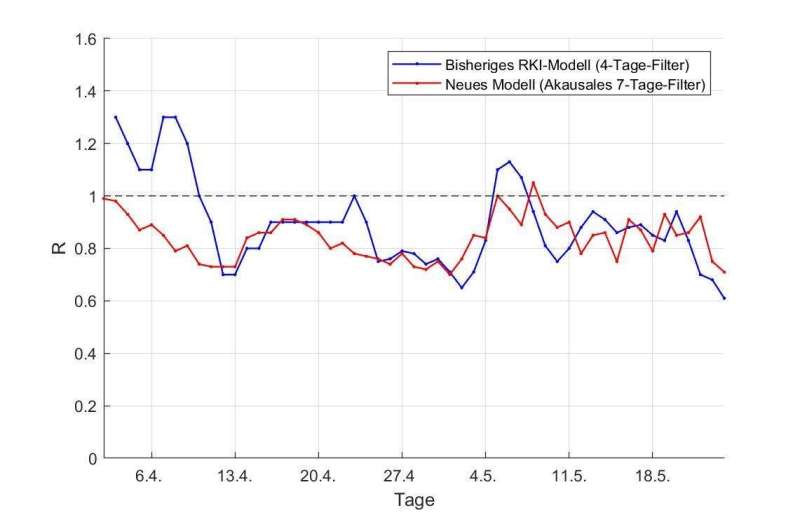Coronavirus reproduction number estimated more precisely

In the pandemic, researchers watch the reproduction number. However, this important number is subject to uncertainties. Researchers of Karlsruhe Institute of Technology (KIT) now present a method to estimate the reproduction number that prevents time delays and compensates day-induced fluctuations. For this purpose, the scientists apply an acausal filter with a filter length of seven days, which uses past, present and future values. Their estimation is made on the basis of the same day of the previous week—similar to load prognosis in the energy sector.
The coronavirus pandemic continues to influence our lives. Each day, new information and latest figures are published. Apart from the number of new cases, the reproduction number R is considered an important indicator of the infection situation. The reproduction number indicates how many persons on the average are infected by an infected person. If R is higher than 1, the number of daily new infections increases, thus attracting particular public attention. The reproduction number is of high importance to coping with the pandemic. Its estimation using mathematical models, however, is subject to uncertainties, partly because the reported cases are dependent on the day of the week and local outbreaks make the number increase sharply.
Researchers of KIT's Institute for Automation and Applied Informatics (IAI) have now developed a method to estimate a time-dependent reproduction number R that prevents undesired time delays and compensates weekly periodicities. Their method is presented in a publication of KIT, with SARS-CoV-2 infections and COVID-19 being used as an example. In addition, they use data published by the Robert Koch Institute (RKI).
The reproduction number is based on the ratio of new infections in two successive time periods. To compensate diagnosis, transmission, and reporting delays, estimation uses a statistical method called nowcasting. A mathematical filter serves to smooth the data to compensate e.g. fluctuations of the weekly curve or distortions due to local outbreaks. For their method, the researchers applied periods of seven days and applied a so-called acausal filter. While causal filters use past and present values only, acausal filters also use future values. Estimation of future infections is based on the same day of the previous week. If necessary, also holidays can be considered.
"Acausal filters prevent undesired time delays that occur when using causal filters," says Professor Ralf Mikut of IAI, who conceived the method. "The approach to estimating future figures based on the same day of the past week has proved to be successful in other sectors showing a weekly periodicity, such as load prognosis in energy time series."
The scientists of KIT compared their method with the existing methods of the RKI and found that the new method compensates weekly periodicities much better and reduces phases in which R only appears to be higher than 1. The scientists recommend a consistent check of the dependence of all reproduction number estimates on the day of the week and use of filters with a filter length of seven days, as well as acausal filters to at least partly compensate time delays in case of day-dependent cases.

















